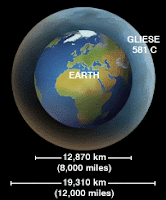 'Is there life anywhere else?'
'Is there life anywhere else?'Astronomers have discovered the most Earth-like exoplanet yet. The planet, the smallest yet discovered, orbits the red dwarf Gliese 581 at a distance one fourteenth of that from Earth to the sun; its year is just 13 days long. However, because the star is so much cooler and less luminous than our own sun, the so-called habitable zone, where planets can carry liquid water, is much nearer the star. As we know, liquid water is critical to life. Moreover, its radius should be only 1.5 times the Earth's radius, and models predict that the planet should be either rocky - like our Earth - or covered with oceans. Scientists made the discovery using the Eso 3.6m Telescope in
 The planet orbits the faint star Gliese 581, which is 20.5 light-years away in the constellation Libra. Gliese 581 c was identified at the European Southern Observatory (Eso) facility at La Silla in the
The planet orbits the faint star Gliese 581, which is 20.5 light-years away in the constellation Libra. Gliese 581 c was identified at the European Southern Observatory (Eso) facility at La Silla in the

No comments:
Post a Comment